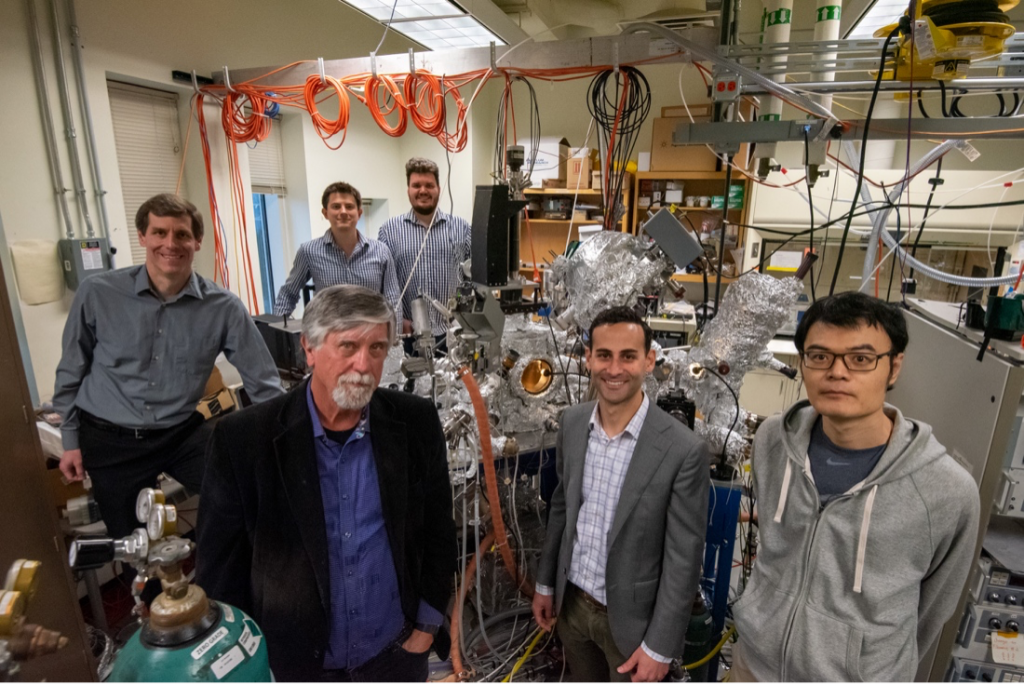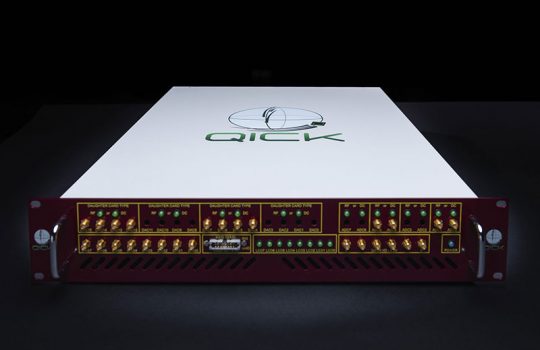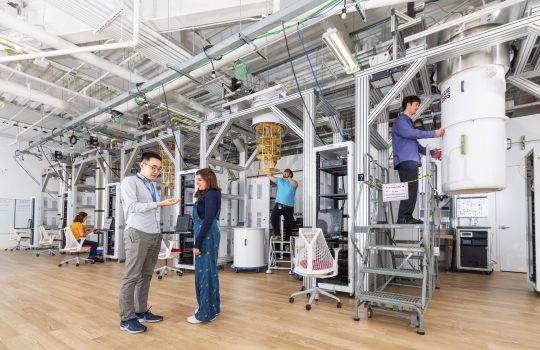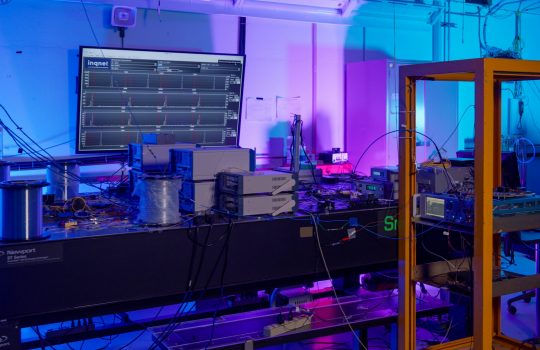Just as the sound of a guitar depends on its strings and the materials used for its body, the performance of a quantum computer depends on the composition of its building blocks. Arguably the most critical components are the devices that encode information in quantum computers.
One such device is the transmon qubit — a patterned chip made of metallic niobium layers on top of a substrate, such as silicon. Between the two materials resides an ultrathin layer that contains both niobium and silicon. The compounds of this layer are known as silicides (NbxSiy). Their impact on the performance of transmon qubits has not been well understood — until now.

The silicide research team. In the front from left to right: Mark Hersam, Michael Bedzyk, James Ronidnelli and Xiezeng Lu. Back: Carlos Torres and Dominic Goronzy. Photo: SQMS Center
Silicides form when elemental niobium is deposited onto silicon during the fabrication process of a transmon qubit. They need to be well understood to make devices that reliably and efficiently store quantum information for as long as possible.
Researchers at the Superconducting Quantum Materials and Systems Center, hosted by the U.S. Department of Energy’s Fermi National Accelerator Laboratory, have discovered how silicides impact the performance of transmon qubits. Their research has been published in APS Physical Review Materials.
An unexpected signal
Carlos Torres-Castanedo was analyzing the materials of a transmon qubit using x-rays, when he came across a peculiar signal.
“I thought the signal came from a surface oxide, because that’s just what usually happens,” said Torres-Castanedo, a doctoral candidate in materials science at Northwestern University. “After spending a day trying to fit the data to match an oxide, the only possibility was to introduce a niobium silicide layer. When the data beautifully fit the model, I showed the results to my co-workers, and we all became excited about what this could mean for transmon qubit performance.”
The SQMS Center researchers dug deeper. They identified the types of silicides present, the thickness of the layer — typically only a few nanometers thick — and its physical and chemical structure. After completing these measurements, they focused on figuring out how these compounds affect the performance of qubits.
The researchers simulated different types of silicides. Not only did they find that silicides are detrimental to the performance of transmon qubits, but they also found that some are more detrimental than others.
Impact on coherence time
Qubits are the basic and fragile units of information that a quantum computer uses to perform calculations. They are physically encoded through transmon qubits.
Similar to a street performer plucking an A note on a guitar string and allowing the tone to ring out before it becomes obscured by street noise, quantum information in a transmon qubit exists for a limited time before it dissipates or is obscured by environmental noise. This time span is known as the coherence time. The longer the coherence time, the better the performance of the transmon qubit.
“This interface will never be like silicon stop, niobium start,” said SQMS Center researcher James Rondinelli, Walter Dill Scott Professor of Materials Science and Engineering at Northwestern University. “The first observation was that there is not an atomically sharp interface, but rather a compositional gradient between the silicon substrate —which is the platform for the system — and the niobium.”
With that observation, Rondinelli and his group began a detailed computational study as part of a greater SQMS Center effort to improve qubit coherence times.
Simulations with a supercomputer
With a newfound curiosity about what the presence of silicides could mean for transmon qubits, the researchers used a supercomputer at the National Energy Research Scientific Computing Center, located at the DOE’s Lawrence Berkley National Laboratory.
Think of silicides as a thin material inside the street performer’s guitar that affects the sound of the guitar string. Researchers studying transmon qubits are essentially trying to isolate an A note and seeing to what extent the hidden material interferes.
Some silicides, for example, have magnetic properties that can interfere with the quantum information that rings out from the transmon qubit. The stronger the magnetism, the more the quantum information is obscured.
Through simulations, researchers found that the silicide compound Nb6Si5 does not have any magnetic properties, while Nb5Si3 introduces magnetic noise. If silicides will always be present in transmon qubits, whether researchers like it or not, Nb6Si5 is less detrimental, and scientists will have to make do.
“To really push the field forward, you have to embrace a little bit of an outsider perspective to make an advancement, and we’re optimistic our multidisciplinary approach will solve this challenge.” – James Rondinelli, SQMS Center researcher
“I find it interesting how the research on the properties of these silicides have been studied since the ’80s, but never have been understood in a nanometer-sized film,” said Torres-Castanedo. “I feel proud that I was able to work alongside my fellow researchers to conduct this important study.”
These findings by themselves are significant. In the greater context of the SQMS Center’s aim to develop a state-of-the-art quantum computer, however, the results have much further implications than just understanding the properties of materials.
“The community who’s worked on superconducting qubits has traditionally been quantum physicists and engineers. The reason the SQMS Center has been so successful is they’ve embraced material scientists,” said Rondinelli. “To really push the field forward, you have to embrace a little bit of an outsider perspective to make an advancement, and we’re optimistic our multidisciplinary approach will solve this challenge.”
The Superconducting Quantum Materials and Systems Center at Fermilab is supported by the DOE Office of Science.
The Superconducting Quantum Materials and Systems Center is one of the five U.S. Department of Energy National Quantum Information Science Research Centers. Led by Fermi National Accelerator Laboratory, SQMS is a collaboration of 24 partner institutions — national labs, academia and industry —working together to bring transformational advances in the field of quantum information science. The center leverages Fermilab’s expertise in building complex particle accelerators to engineer multiqubit quantum processor platforms based on state-of-the-art qubits and superconducting technologies. Working hand in hand with embedded industry partners, SQMS will build a quantum computer and new quantum sensors at Fermilab, which will open unprecedented computational opportunities. For more information, please visit sqmscenter.fnal.gov.
Fermi National Accelerator Laboratory is supported by the Office of Science of the U.S. Department of Energy. The Office of Science is the single largest supporter of basic research in the physical sciences in the United States and is working to address some of the most pressing challenges of our time. For more information, please visit science.energy.gov.



